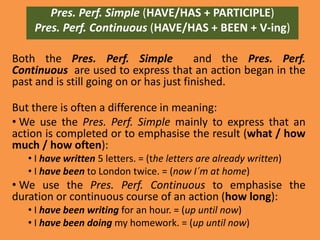Pres. perf. simple vs pres. perf. contin.
•Download as PPTX, PDF•
0 likes•867 views
Report
Share
Report
Share

Recommended
Recommended
More Related Content
What's hot
What's hot (16)
Similar to Pres. perf. simple vs pres. perf. contin.
Similar to Pres. perf. simple vs pres. perf. contin. (20)
More from myenglishcorner
More from myenglishcorner (20)
Pres. perf. simple vs pres. perf. contin.
- 1. Pres. Perf. Simple (HAVE/HAS + PARTICIPLE) Pres. Perf. Continuous (HAVE/HAS + BEEN + V-ing) Both the Pres. Perf. Simple and the Pres. Perf. Continuous are used to express that an action began in the past and is still going on or has just finished. But there is often a difference in meaning: • We use the Pres. Perf. Simple mainly to express that an action is completed or to emphasise the result (what / how much / how often): • I have written 5 letters. = (the letters are already written) • I have been to London twice. = (now I´m at home) • We use the Pres. Perf. Continuous to emphasise the duration or continuous course of an action (how long): • I have been writing for an hour. = (up until now) • I have been doing my homework. = (up until now)
- 2. PRES. PERF. SIMPLE PRES. PERF. CONTINUOUS Ever Never All (day, week, …) Already For Just Since Still This week, year, … Yet Recently